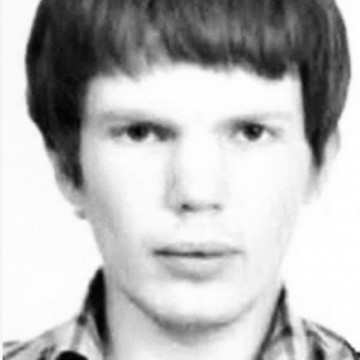For citation, please use:
Chemakin, A.A., 2023. Ethnic Composition of Kiev Population in Early 20th Century: A Snapshot of Actualized History. Russia in Global Affairs, 21(1), pp. 32-48. DOI: 10.31278/1810-6374-2023-21-1-32-48
It is only recently that international relations experts have come to recognize the “importance of social processes of identity formation, culture and ideology… for the study and practice of world politics” (Lawson, 2006, p. 3). An analysis of common historical experience of various groups of people united—or divided—by social and political practice may help us find the root causes of modern crises and ways to overcome them.
At the dawn of the 20th century, Kiev was the seventh most populous city in the whole of the Russian Empire. For many centuries following the Tatar-Mongol invasion, the former capital of Ancient Rus was in decline. While remaining an important religious center, the city enjoyed little economic and political significance. It was no earlier than the second half of the 19th century, after the “great reforms” and the beginning of the capitalist boom, that Kiev’s role began to increase and its population to grow by leaps and bounds. Kiev acquired the status of an important trading and educational center. Local industries were thriving, although the population’s working-class segment was noticeably inferior to that of Kharkov or Odessa. By and large the city remained a typical city of the petty bourgeoisie.
In the second half of the 19th century, Kiev played an extremely important role for the formation of Russian and Ukrainian nationalists’ movements. The former saw Kiev as the “mother of Russian cities” and the historical capital of Rus, while for the latter it was the future capital of an autonomous Ukraine, or even, as (and if) luck would have it, of an independent country. By the beginning of the 20th century, the Poles had given up the hope of bringing Kiev back to Rzeczpospolita, which they dreamed of reviving someday, but for them, as well as for Jews, the city was an important cultural and economic center. Ethnic diversity and the parallel existence of four fairly strong nationalist movements, each having its own vision of Kiev’s future, lent the city a special character and made interethnic relations extremely complex and tangled (Hamm, 1993).
Fuzzy boundaries of self-perception
According to the all-Russia census of 1897, Kiev had a population of 247,723: 192,139 that embraced Russians (77.56%), including 134,278 native speakers of the Great Russian language (54.20%), 55,064 speakers of Little Russian (22.23%), and 2,797 speakers of Belarusian (1.13%). There were two more large language communities: Jewish—29,937 (12.08%), and Polish—16,579 (6.69%) (Troinitsky, 1904, pp. 98-99). It should be noted that the category “Great Russian language” included not only Great Russians but also Little Russians speaking literary Russian.
In the fall of 1917, six months after the February Revolution, a new population census was conducted in Kiev, which registered 467,703 residents representing 69 nationalities (7,291 did not answer the question about their nationality).
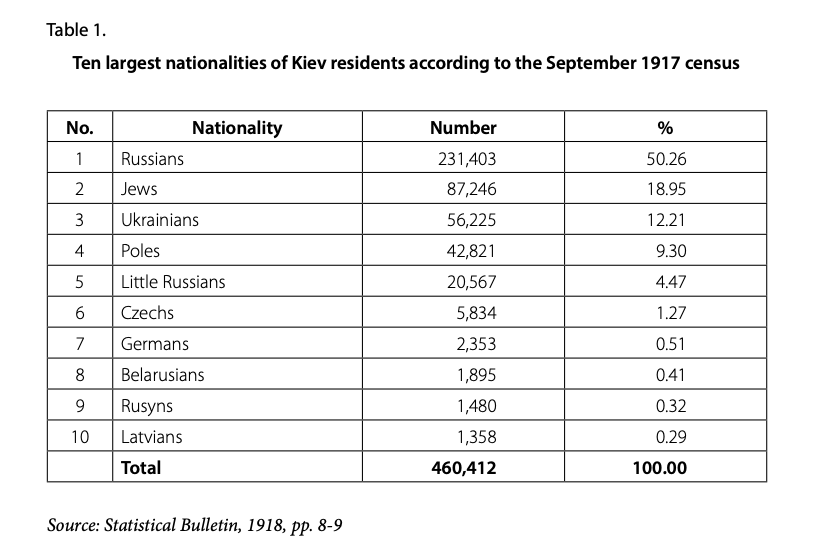
As follows from the table, those who were registered as Russians and divided into three groups by their native language in the 1897 census, in 1917 were listed as five separate nationalities: Russians, Ukrainians, Little Russians, Belarusians, and Rusyns. The ill-conceived methodology used in the 1917 census caused serious confusion.
According to official instructions, the ‘nationality’ section was to be filled with the “interviewee’s response” to the question “What nationality do you identify yourself with?” (DAK, n.d.; Rabochaya zhizn’, 1918, p. 2). Had this requirement been strictly observed, the result would certainly have been different. For example, not a single Great Russian would have been found in Kiev, although there were even some Turkomans and Votyaks [Udmurts] among the city’s dwellers. Apparently, after collecting all data a decision was made to apply the name ‘Russians’ to both those who called themselves Russians, without dividing them into regional sub-ethnic groups, and those who identified themselves as Great Russians. This approach added to the extremely confusing situation regarding nationalities in Kiev. While the statistics concerning Jews, Poles, and Czechs obviously reflected the reality, the division of “former” Russians into several categories was very dubious. “Ethnic composition data bear an unavoidable trace of certain subjectivity,” said the daily Kievskaya Mysl. “The attribution of the respondent to one or another nationality depends on the level of national self-consciousness, and on the conditions of the political moment. In particular, this applies to peoples whose self-identity has not yet been completely formed” (Kievskaya mysl, 1918, p. 3).
The category ‘Little Russians’ evoked too many questions. Which people identified themselves that way? Those who considered themselves to be Russian, but at the same time placed the regional Little Russian identity above everything else? Or those who called themselves that way simply out of habit as before the February Revolution the name ‘Little Russians’ had been considered the only correct one for the indigenous population of the southwestern and—partly—southern provinces of the Russian Empire? Who were those 20,000 Little Russians in Kiev—careless and indifferent Ukrainians or, conversely, Russians who purposely called themselves that way to spite the Ukrainians? And, if those who called themselves Little Russians were registered as such, then what category did ‘Khokhols’ fall into (after all, such self-identity was no less, and sometimes even more common then)? In his memoirs, Yuri Tyutyunnik, a Ukrainian military leader, recalls that about half of the 7,000 soldiers whom he interviewed in Simferopol in March 1917 and who represented “Ukrainian” provinces, called themselves Little Russians; about a third, Khokhols; and only about 300 said they considered themselves Ukrainians (Tyutyunnyk, 2004, p. 15). Obviously, the number of Khokhols among the Kievites was relatively small, but it is likewise obvious that their complete absence was improbable. So, the census-takers either adjusted the results at their own discretion, guessing for the interviewees what nationality the latter belonged to, or asked leading questions, thus persuading the respondents to attribute themselves to one or another category (although no “official” list of nationalities compiled in advance by the census organizers has been found).
Complaints were frequent in the Ukrainian press that the respondents who identified themselves as Ukrainians were listed as Russians. Allegedly, on September 12, 1917, a female census taker, who had knocked on the door of 26 Bolshaya Vasylkivska Street, said: “What? Ukrainian? I can’t write this down. I was told at the headquarters what to write. Nothing was said about Ukrainians. Only Russians can be written down. I have already listed 600. Stop lecturing me, please. I know all myself.” “What is this census really worth, if the Black Hundreds’ members or cretins were commissioned to do this job?” the Ukrainian daily Robitnycha Gazeta (1917, p. 4) asked angrily. There were other curious incidents reported by the Ukrainian press: on Kudryavskaya Street, for example, a university student serving as a census taker, in response to a woman’s response that she was Ukrainian, said: “How come such intelligent people suddenly turn out to be Ukrainians? Take your neighbors—the Petrenko family. They are from the Poltava province, too, but they are Russians” (Sugma, 1918, p. 4). University student Kozachinsky, a census taker in the Zverinets district, complained that “among the census takers one could meet those sharing Shulgin’s ideas; there were also ‘internationalists’” (Kozachinsky, 1917, p. 4). And a resident of the Podol neighborhood complained that he and his neighbor were listed as Russians, although they considered themselves to be Ukrainians (Glushchenko, 1917, p. 4). A member of the Kiev provincial executive committee, Korolev, said that a Jewish female census taker was surprised to hear that he would like to be listed as Ukrainian. She explained that usually people called themselves ‘Little Russians,’ but since she “knows well that there is no such nationality as ‘Little Russian,’ she registers them as ‘Russian’.” The woman explained that she and her colleagues had not received any instructions from the Bureau of Statistics, but as “cultured people” they considered it possible to correct “inaccuracies”(Koroliv, 1917, p. 4). In the end, the Kiev City Ukrainian Rada, “having learned that the census takers in Kiev had often refused to record people as ‘Ukrainians,’ made insulting comments about Ukrainianism, and arbitrarily attributed Ukrainians to other nationalities,” slammed the census takers’ behavior as shameful, and the census itself as incorrect and inadequate to the real size of the Ukrainian population, and therefore strongly demanded that the results of that census should not be used as the basis of official statistics (Nova Rada, 1917b, p. 2).
It is quite possible that cases of people calling themselves Ukrainians or Little Russians but being recorded as Russians did occur. But still, it looks like those were minor distortions that could not change the overall picture. It is also important that they were caused not by the Statistics Bureau’s bias, but by the arbitrariness of individual census takers (there were 1,500‒2,000 of them, appointed regardless of their own nationality (Kievskaya mysl, 1918, p. 3) and poorly developed census methodology. However, the claims that could be heard from the pro-Ukrainian lobby in this case do not look convincing enough. Firstly, alongside the urban census, there was also a census in the countryside, which was entirely controlled by the Ukrainians. The census takers, according to the instructions, were prohibited from recording anyone as a Russian or a Little Russian, but only as a Ukrainian or a Great Russian, etc. For example, one of the respondents of a Belarusian background, who insisted that he was Russian, was eventually listed as “Great Russian” (Sharevych, 1917, p. 2). Of course, the Ukrainians did not care about such falsifications—committed not due to individual census takers but rooted in the census methodology itself. Secondly, what, in their opinion, should the “correct” census in Kiev have been like? The answer is quite simple: all those who called themselves Little Russians should have been recorded as Ukrainians, just like those in the countryside. As the newspaper Nova Rada noted, the Statistics Bureau should have been obliged to “explain to its poorly educated agents that actually this term—‘Ukrainian’—should be used instead of ‘Little Russian,’ that Kiev’s benighted and uneducated philistines think, in accordance with the old police rule, that once a person is Orthodox, he is also Russian, and his language is Russian” (Nova Rada, 1917a, p. 1).
Although some cases of census takers’ biased attitude could well have taken place, in my opinion, they did not affect the overall results. Even if the number of Ukrainians was understated, surely not by an order of magnitude. Many leaders of the pro-Ukrainian movement admitted that Ukrainians were a minority in Kiev. For example, Isaac Mazepa, Chairman of the UNR Council of Ministers in 1919‒1920, wrote that Kiev was “three-quarters alien, not Ukrainian” (Mazepa, 1951, p. 71).
Ukrainians believed that Little Russians were careless and irresponsible people to whom malicious census takers had not explained that they were actually Ukrainians. Consequently, representatives of the pro-Ukrainian movement tended to add them to the Ukrainians, who in that case would make up almost 17% (or exactly 17% with Rusyns counted, too). Kiev’s left-wing liberal press was partly in agreement with them on this issue. For example, the newspaper Kievskaya Mysl, in its comparison of the results of the 1917 census with the results of the 1897 census, interpreted the Ukrainian and Little Russian languages as one (Kievskaya Mysl, 1918, p. 3). In the Soviet era, the analysts of the 1917 census automatically added Little Russians to the Ukrainians, without even making a reservation that such a category existed (Borovsky, 1926, pp. 432, 434; for the author’s original manuscript in Russian, see: VNLU, n.d.). Russian nationalists, on the contrary, believed that Little Russians should be considered Russians. “The very words ‘Little Russian’ clearly indicate that a person who self-defines him/herself in this way does not consider him/herself to be a Ukrainian, that is, a representative of a completely different people, but positions oneself as a Russian of Little Rus, in other words, a Little Russian,” wrote Sergey Hrushevsky, a member of the Kiev Club of Russian Nationalists (Hrushevsky, 1918, p. 55).
This problem could have been partly solved had the census takers asked whether this or that person considered him/herself part of a single Russian people or a representative of a separate nationality, and, depending on the answer, the Kievites could have been divided into Ukrainians and Russians. The latter, in turn, would have been classified as Little Russians, Great Russians, Belarusians, Rusyns or those who considered themselves simply Russians regardless of the regional variety. But even if such an approach would have helped to obtain more adequate results, conducting a census that would have produced “strictly scientific” data looks utterly impossible.


The existence of “independent” Ukraine throughout 1918 contributed to a significant increase in the number of Ukrainians, including those who in 1917 considered themselves Russians.[1] Conversely, the collapse of Ukrainian statehood in 1919‒1920 led to a decrease in the number of Kievites who considered themselves Ukrainians.[2] In any case, in analyzing Kiev’s ethnic composition, one cannot but take into account the opportunistic wish of its residents to join the winning side (Borovsky, 1926, p. 436). In 1919, a very telling cartoon was published in a Bolshevik daily showing a Kievite adapting to one or another political regime—Soviet, Petliuravite or Denikinite. At first, he is depicted as “sympathetic” towards the Bolsheviks, wearing working class clothes; then the same person in a 17th-century Cossack outfit looks like a “genuine” Ukrainian; and finally, he appears in the attire of the “law-abiding urban middle class”—a “bourgeois” suit, top hat and monocle, a newspaper sticking out of his pocket, the front-page headline reading “God Save the Tsar” (Bolshevik, 1919, p. 2). Despite an obvious exaggeration, there is a grain of truth in such a description of the townsfolk’s behavior.
Fortunately, the census takers not only asked Kiev residents what nationality they belonged to, but also collected information about their native and spoken language, place of birth, and occupation. This data gives a better understanding of who decided to be listed as Russians, Little Russians, or Ukrainians.

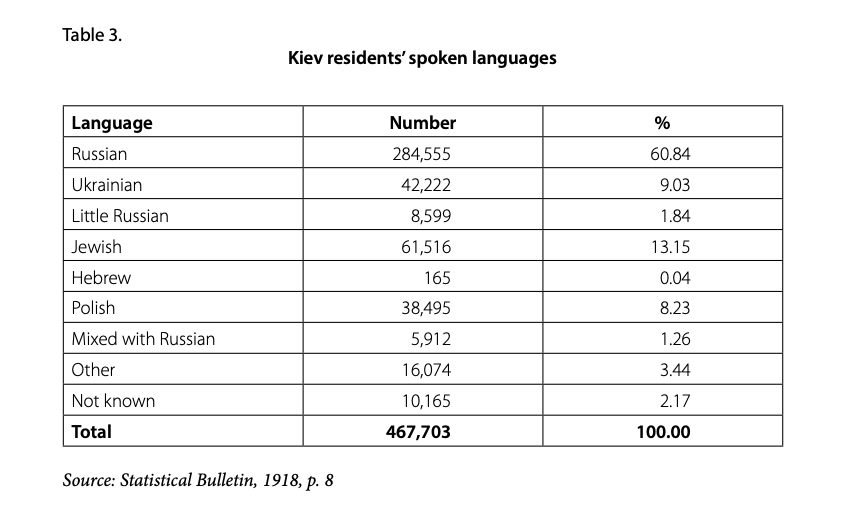
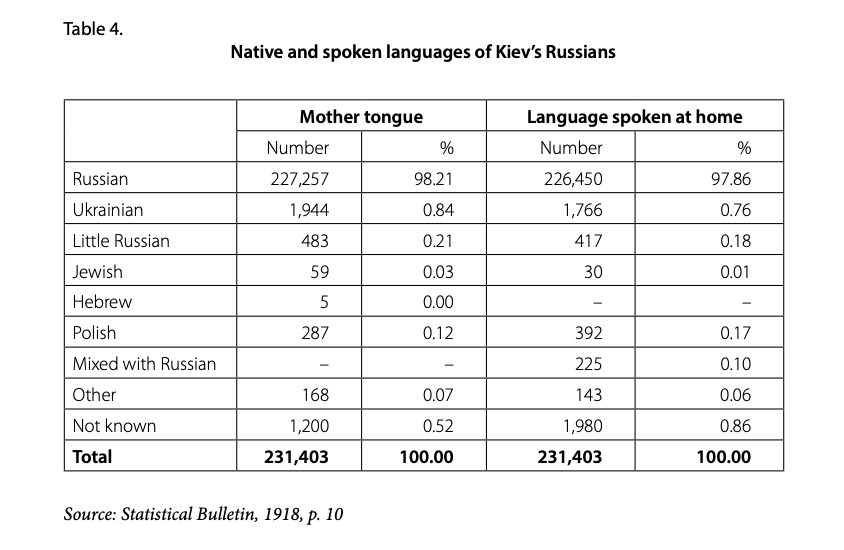
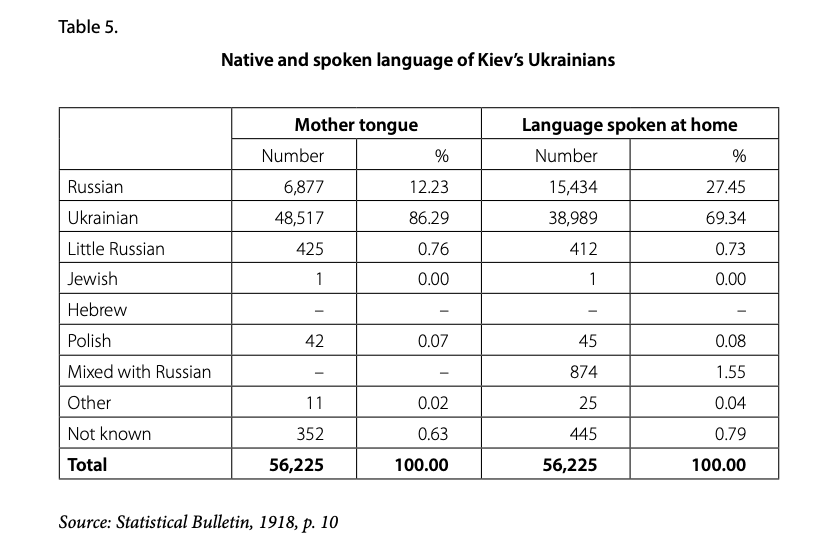
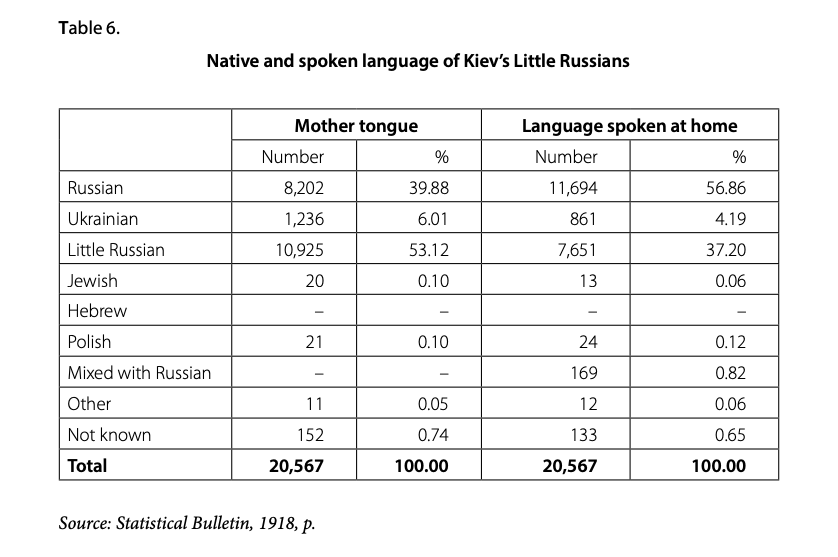
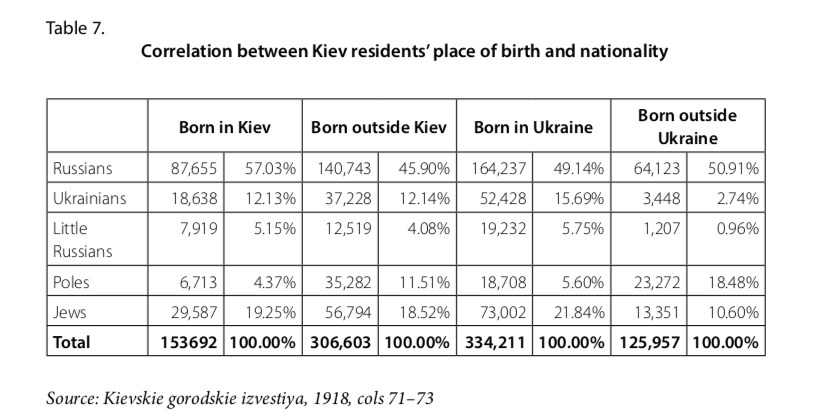
As follows from the tables above, the number of Kievites who spoke Russian was larger than the number of Kievites who considered Russian their native language, and that, in turn, exceeded the number of Kievites who considered themselves Russians. As for other nationalities, the census showed a reverse picture: the number of people who considered themselves Jews, Ukrainians, Poles or Little Russians was greater than the number of people speaking these languages. In everyday life, Russian was spoken by more than half of the Little Russians and almost a third of the Ukrainians.
It is also very indicative that the share of Russians and Little Russians among people born in Kiev is much greater than that among all Kievites. Kiev was the birthplace for 38.38% of Russians (87,655 out of the 228,398 Russians who indicated their place of birth), 33.36% of Ukrainians (18,638 out of 55,866) and 38.75% of Little Russians (7,919 out of 20,438). Meanwhile, Ukraine, within the 1918 borders, was the birthplace for 71.92% Russians (164,237 out of 228,360), 93.83% Ukrainians (52,428 out of 55,876), and 94.09% Little Russians (19,232 out of 20,439).
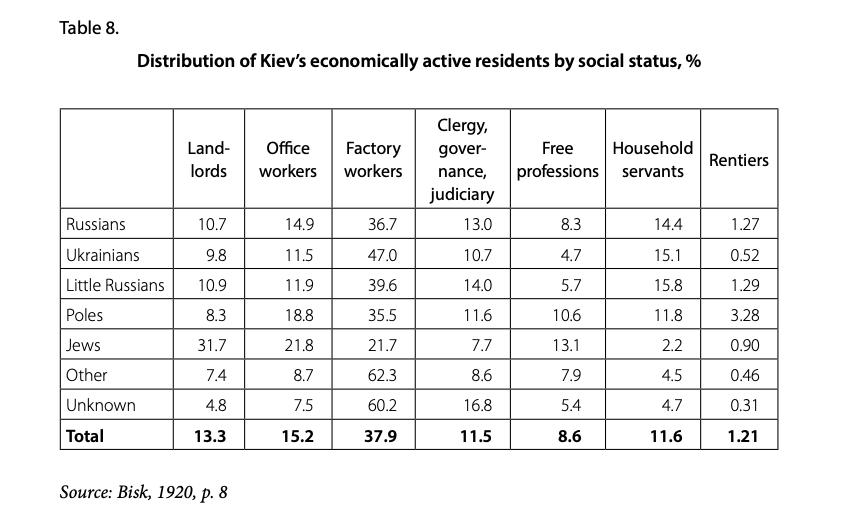
The group of Ukrainians among Kiev residents was the most “democratic” in terms of composition: the number of “bureaucracy elements” and landlords was smaller among them than in other categories, while blue collar workers had a significant representation (almost 50%). As for Russians and Little Russians, in terms of their social composition, they were very similar, with the percentage of landlords, blue collar workers, civil servants, and rentiers being almost the same (Bisk, 1920, p. 9).
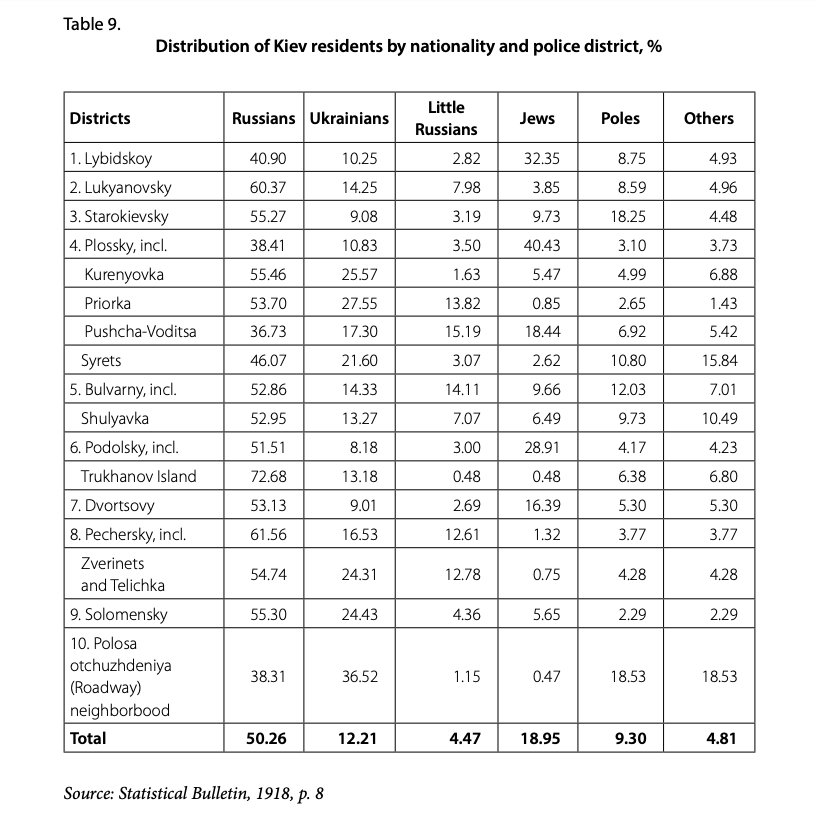
Russians prevailed in all districts of Kiev, except for the Jewish Plossky District, and in seven out of ten districts Russians were an absolute majority. Ukrainians lived mainly on the outskirts bordering rural communities (Kurenyovka, Priorka, Syrets, Zverinets and Telichka, Solomenka, Polosa Otchuzhdeniya). There were many Little Russians both on the outskirts (Priorka, Pushcha-Voditsa, Pechersky districts), and in the Bulvarny District located in the center. An analysis of the distribution by region and the economic situation shows that Little Russians, like Ukrainians, lived mostly on the outskirts, but at the same time were superior to them in social status.
There is no reason to believe that Ukrainians were somehow discriminated and occupied unprivileged positions. On the contrary, it looks like the situation was the opposite: those who retained bonds with the countryside and had non-prestigious professions, were inclined to call themselves Ukrainians in 1917. Meanwhile, Little Russians, similarly often linked with rural areas, regarded their social position as satisfactory and therefore were not inclined to take revolutionary steps. Of course, the inertia of mentality also played a role: the 1919 census shows that among the Little Russians there were a bit more adults and elderly people than among the Ukrainians (Census, 1920, Tab. IV). Thus, theoretically, the category of Little Russians could include Anatoly Savenko, Chairman of the Kiev Club of Russian Nationalists, who, when answering the same question in the Duma questionnaires on different occasions, called himself alternately Russian or Little Russian (RGIA, n.d.), and an old peasant woman living on the outskirts, who was accustomed to calling herself that way while being not receptive to the latest “pro-Ukrainian” trends and ignorant in politics. I believe, there are several more grounds for merging the category of Little Russians with the category of Russians (among which, obviously, a significant part, and perhaps a majority, were also Little Russians—for the simple reason that these people placed their national identity first), although it is worth admitting that any mechanical merger of certain categories will not be correct.
Yet one way or another, with or without account of Little Russians, Russians made up an absolute majority of Kiev’s population, and it was difficult to argue with this hard fact. “In a word, Kiev is a Russian city and, in particular, a city of Russian culture,” Sergey Hrushevsky concluded after studying the results of the census. “And as long as this city, the heart of Little Russia, is Russian, then the whole region, despite all the attempts at forced Ukrainization, will obey its powerful cultural influence and will always maintain a living affection and love for the great Russian culture” (Hrushevsky, 1918, p. 58).
The study was funded by the Russian Science Foundation, Project 21-78-00015, https://rscf.ru/en/project/21-78-00015/
[1] The census of Kiev’s population, conducted on March 3 (16), 1919, shortly after the Red Army entered the city, produced the following results: Russians—232,148 (42.65%), Ukrainians—128,664 (23.64%; including 119 Rusyns), Jews—114,524 (21.04%), Poles—36,828 (6.77%), Little Russians—8,259 (1.52%). The city’s population increased by more than 80,000 to 544,369 (Census, 1920, Tab. II). However, this increase occurred, firstly, as a result of the takeover of a number of surrounding communities (in particular, Demiyevka) and secondly, due to the influx of refugees.
[2] According to the 1920 census, Kiev was home to 171,655 Russians (46.72%), 117,041 Jews (31.86%), 52,443 Ukrainians (14.27%), 13,820 Poles (3.76%), and 12,430 people of other nationalities (3.38%), while there was a significant decrease in the entire urban population by almost 180,000 (Borovsky, 1926, p. 434). The number of Ukrainians shrank by 60%(!), which cannot be blamed entirely on the exodus of some of them together with the retreating troops of the UNR and the Poles in June 1920. In December 1919, a considerable part of the Russian population was evacuated from Kiev together with the White Guard forces, but at the same time the share of Russians in the population increased. It is obvious that the collapse of Ukrainian statehood made some people who called themselves Ukrainians at the beginning of 1919 change their mind in 1920 to declare they were Russians.
Bisk, I.S., 1920. K voprosu o sotsialnom sostave naseleniya g. Kieva (po dannym perepisi 1917 g.) [On Social Composition of the Population of Kiev (According to the 1917 Census)]. Kiev.
Bolshevik, 1919. Soglashatel prisposoblyaetsa [Compromiser Adapts]. Bolshevik, 108, p. 2.
Borovsky, M., 1926. Natsionalno-sotsiyalni peregrupovannya lyudnosti mista Kyi’va v porevolyuciynykh chasakh (1917–1923) [National and Social Regroupings of the Population of the City of Kiev in the Post-Revolutionary Period]. In: M. Hrushevsky (ed.) Kiev ta yogo okolytsya v istorii i pamyatkakh [Kiev and Its Outskirts in History and Memorials]. Kiev: Derzhave vydavnyctvo Ukrainy, pp. 431-475.
Census, 1920. Perepis’g. Kieva 16 marta 1919 g. Ch. 1. Naselenie [Census of the City of Kiev on March 16, 1919. Part 1. Population]. Kiev: Kievskoe gubernskoe statisticheskoe byuro.
DAK, n.d. State Archives in the City of Kiev. DAK, F. 163, Op. 31, Spr. 318, L. 25–25back.
Glushchenko, N., 1917. Jak perevodyat’ perepys [How the Census Is Conducted]. Robitnycha gazeta, 135, p. 4.
Hamm, M., 1993. Kiev: A Portrait, 1800–1917. Princeton: Princeton University Press.
Hrushevsky, S., 1918. Natsionalny sostav naseleniya g. Kieva [National Composition of the Population of Kiev]. Malaya Rus, 3, pp. 53-58.
Kievskaya Mysl, 1918. Rezultaty kievskoj perepisi [Kiev Census Results]. Kievskaya Mysl, 39, p. 3.
Kievskie gorodskie izvestiya, 1918. Rezultaty predvaritelnogo podschyota naseleniya g. Kieva po mestu rozhdeniya [Results of Preliminary Census of the Population of Kiev by Place of Birth]. Kievskie gorodskie izvestiya, 19, cols. 71-73.
Koroliv, V., 1917. Lyst do redakcii [Letter to the Editor]. Nova Rada, 139, p. 4.
Kozachinsky, K., 1917. Lyst do redakcii [Letter to the Editor]. Nova Rada, 144, p. 4.
Lawson, G., 2006. The Promise of Historical Sociology in International Relations. International studies review, 8 (3). pp. 397-423. DOI: 10.1111/j.1468-2486.2006.00600.x
Mazepa, I., 1951. Ukrai’na v ogni j buri revolyutsii’ 1917–1921. T. II. Kamjanec’ka doba – Zymovyj pohid [Ukraine in the Fire and Storm of the Revolution of 1917–1921. Vol. II: Kamianets Time – Winter Campaign]. Munich: Vydavnyctvo Prometei.
Nova Rada, 1917a. Falshovana statystyka [Falsified Statistics]. Nova Rada, 139, p. 1.
Nova Rada, 1917b. Zbory Miys’koi Ukrains’koi Rady [Meeting of the City Ukrainian Council]. Nova Rada, 145, p. 2.
Rabochaya zhizn’, 1918. Naselenie Kieva po natsionalnostyam [Population of Kiev by Nationality]. Rabochaya zhizn’, 20, p. 2.
RGIA, n.d. Russian State Historical Archive. RGIA, F. 1278, Op. 9, D. 694, L. 1back, 3.
Robitnycha gazeta, 1917. Chernosotenstvo abo kretynizm [Blackhundredism or Сretinism]. Robitnycha gazeta, 134, p. 4.
Sharevych, L., 1917. Orygynal’naja perepys’ [Original Census]. Kievlyanin, 188, p. 2.
Statistical Bulletin, 1918. Statistichesky byulleten’ po gorodu Kievu. Janvar’ – fevral – mart 1918 g. [Statistical Bulletin on the City of Kiev. January – February – March 1918] Iss. 1. Kiev.
Sugma, V., 1918. Do perepysu 1917 r. gromadyanstva m. Kieva [On the 1917 Census of the Population of Kiev]. Borot’ba, 37, p. 4.
Troinitsky, N.A. (ed.), 1904. Pervaya vseobshhaya perepis’ naseleniya Rossiiskoi imperii. T. XVI. Kievskaya guberniya [The First General Census of the Population of the Russian Empire. Vol. XVI. Kiev Province]. St. Petersburg.
Tyutyunnyk, Y., 2004. Revolyucijna styhija. Zymovyj pohid 1919–1920 rr. [Revolutionary Nature. Winter Campaign 1919–1920] Lviv: Universum.





